ISSN ONLINE(2319-8753)PRINT(2347-6710)
ISSN ONLINE(2319-8753)PRINT(2347-6710)
Ernest Boampong1, Bernard Effah2
|
| Related article at Pubmed, Scholar Google |
Visit for more related articles at International Journal of Innovative Research in Science, Engineering and Technology
Keywords |
| Furniture, Mono-desk, Students, Classroom furniture, Back pain, Senior high school. |
INTRODUCTION |
| The classroom is a formal environment for learning. A conducive and comfortable classroom environment motivates students to perform better and encourage the learning process. A study conducted by Chakrabarti [1] found that the seating furniture adapted to body dimensions increase the learning effectiveness and as such care should be taken to see that furniture is designed appropriately to suit the student’s anthropometries. Students spend long hours of sitting while reading, writing and looking on the chalkboard in the classroom [2]. They often study in prolonged hours in awkward and static postures in the classroom. Students often sit in poorly designed and awkward desk arrangements. Awkward desk arrangements and prolonged sitting in classroom may cause muscles and other soft tissues to become stretched or shortened compared to normal [3]. Students are at special risk for suffering negative effects from badly designed and ill-fitting furniture owing to the prolonged period spent seated during school. Muscles may be overworked or become constantly contracted while blood and lymph flow may be constricted. Soft tissue may become inflamed and nerves may even get irritated. Pain from poor or prolonged postures may present headaches, neck and low back pain, upper back pain and pain in shoulder. Neck pain from poor posture in classroom is due to neck flexion and neck rotation in the classroom due to the student’s position in the classroom when watching the chalkboard [3]. Once the head is flexed forward or rotated, when watching the chalkboard, the vertebrae do not support the weight of the head as muck [4]. |
| Improper designs will make sitting to require greater muscular force and control to maintain stability and equilibrium. This in turn, results in greater fatigue and discomfort and likely to lead to poor postural habits as well as neck and back complaints. Most important for students, musculoskeletal stress resulting from efforts to maintain stability comfort seating may make for a restless individual a condition not conducive to focused learning. |
| Ergonomics is the study of the design of objects, systems and environments for their safe and efficient use by people [5]. Proper ergonomic design is necessary to prevent repetitive strain injuries, which can develop over time and can lead to long term disability [6]. Ergonomics is employed to fulfil the two goals of health and productivity. It is relevant in the design of such things as safe and easy to use school furniture and there are costs involved in products that do not reflect designs based on properly selected anthropometric data and ergonomics. |
| Classroom furniture from manufacturers in Ghana is not specifically designed to accommodate the dimensions of the individual users. While a few desks offer an overall height adjustment and chairs of different sizes, individual adjustment for the seat, arm and back are not offered. Instead, a one-size-fits philosophy has been adopted in the industry, because such furniture is less costly to manufacture and easier to sell at a lower price. Manufacturers base their designs on their own specifications. The only things considered are the seat width and belly room. These manufacturers main concern was to sell furniture not to safety of customers. Existing designs have basically been unaltered for years [3].There is evidence that a large percentage of students are sitting in chairs that are either too high or too low for their height. This leads to feet dangling in the air which increases back pressure or on the other hand, to a crunching of the knee area which enforces bad postures as well as constricting of the leg muscles. Wayside designers are not applying principles for the design and construction of classroom chairs and tables in Senior High School because the furniture designed do not fit all students. Almost all the furniture designed and used in schools does not conform to standards due to lack of knowledge in ergonomics during designing and construction [1]. Students aged 18 and even lower are more susceptible to chronic musculoskeletal disorders than adults, since their bones are still in the development stage [7]. Also students complain of pains around their neck, low back and upper back and concentration of impairments are all negative effects which result from prolonged sitting [8]. These pains also have substantial negative impact on their education and health. As an outcome of the study, mono-desk became unsuitable for students, compelling them to adopt awkward posture while attending their classes. Flaws in the furniture used by the students contribute to discomfort and inconvenience, adversely affecting classroom learning activity [1]. |
| Generally, in normal school environment, many factors can influence students sitting postures; these include the anthropometric dimensions of students, the measurements and design features of the furniture [7]. The idea of total classroom ergonomic might still be out of reach, there are ergonomic features schools can look for when purchasing standard classroom chairs while they may not seem significant, these features can make a big difference in helping students to sit in a healthy way as possible. These features areWaterfall-front seats, thus seats that slope downwards at the edges of seat under the knee.Lumbar support or lower back support which represents itself as a curve in the back of the chair, just above the point where the back and seat come together and Flexible backwhich enables students to lean back a bit when they feel the need, alleviating leg and back pressure. It is against this background that sitting postures in classrooms are being discussed with extent of neck pain, upper back pain and lower back pain experienced by students aged 17-22 years to assess the complaints from students after sitting on their class room furniture (mono-desk) over specified period of time. |
II. MATERIALS AND METHODS |
Sample and study design |
| The study was carried out at Agona Senior High Technical School in the Sekyere South district of Ashanti Region in Ghana. Since we could not study the entire population because of feasibility and cost constraints, we selected a representative sample from the population of students for observation and analysis. Sampling is the statistical process of selecting a subset of a population of interest for purposes of making observations and statistical inferences about that population [9]. Four classes each of second and third year classes were purposefully selected for the study. A systematic random sampling method was used to choose a sample of 120 students from a population of 482 students. The subjective evaluation of the health problem of the students was made by questionnaire technique. A detailed health and lifestyle questionnaire was administered after various observational scenarios. The questionnaire was based on the Standard Nordic Questionnaire (SNQ) [10], [11]. Postural analyses of the students during normal classroom lessons were also made by video-photographic method. |
Observation method |
| Observation as a method is commonly used in the behavioural sciences. Observation becomes a scientific tool and the method of data collection for researchers, when it serves a formulated research purpose, is systematically planned, recorded and subjected to checks and controls on validity and reliability [9], [12]. One advantage of this method is that subjective bias is eliminated, if observation is done accurately [12]. Under the observation method, the information is sought by way of investigator’s own direct observation without asking from the respondent. Observation is a good way of getting below the surface of any situation and to help reveal complex causal social processes [13]. Structured observations were conducted by the researchers to complement the findings of the questionnaire to draw meaningful conclusions from the study.Observation guidelines and measures suggested by Kothari [12], Bhattacherjee [9] and Neville [13] were taken into consideration to ensure the credibility and reliability of using observation for data collection. Figure 1 depicts the mono-desk used by students of the school were the study was conducted. |
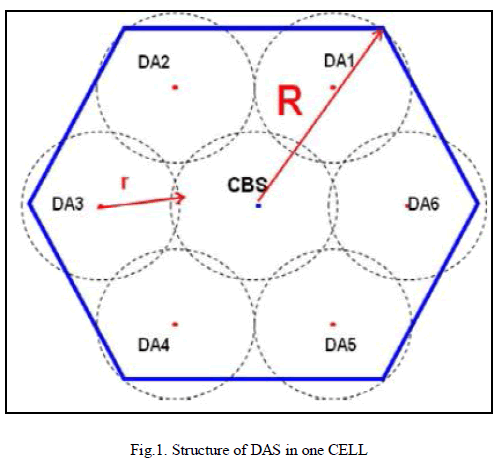 |
| [A - Height of desk; B - Inclination of top and side; C - Desk Clearance; D - Width of desk; E - Depth of desk; F - Thickness of desk; G - Footrest; H - Height of footrest; K - Height of seat; L - Width of chair; M - Height of chair; N – Backrest; P - Pan Thickness; J - Depth of seat] |
III. EXPERIMENTAL RESULTS |
Basic information |
| There were 120 Senior High School students involved in the study. The ages of the students were between 17 years and 22 years with a mean age of 19years. Fourteen percent of them were 17 years, 33.3% were 18 years, 25% were 19 years, 18.3% were 20 years, and 4.2% were 21 years, and 5% were 22 years. The heights of the students were between 150 cm and 192 cm with a mean height of 169 cm. The weights of the students were between 43.3 kg and 92.1 kg with a mean weight of 56.6 kg. |
 |
| The results in Table 1 indicated strong negative correlation of students’ satisfaction with the backrest shape according to the height of students with negative significance (i.e.-0. 069). There was also strong negative correlation of students dissatisfaction with the height of mono-desk according to students heights in classes with negative significance (i.e. - 0.168*). This implies that there was a strong dissatisfaction with the height of the mono-desk. Also there was a strong disapproval of students not feeling comfortable with classroom furniture (i.e. - 0.173). The correlations of students’ satisfaction with backrest shape of mono-desk according to students in the classes, students’ satisfaction with backrest shape of mono-desk according to the weight of students and students’ comfortability with furniture according to students’ height were positive but not significant with values 0.86, 0.038 and 0.049 respectively. |
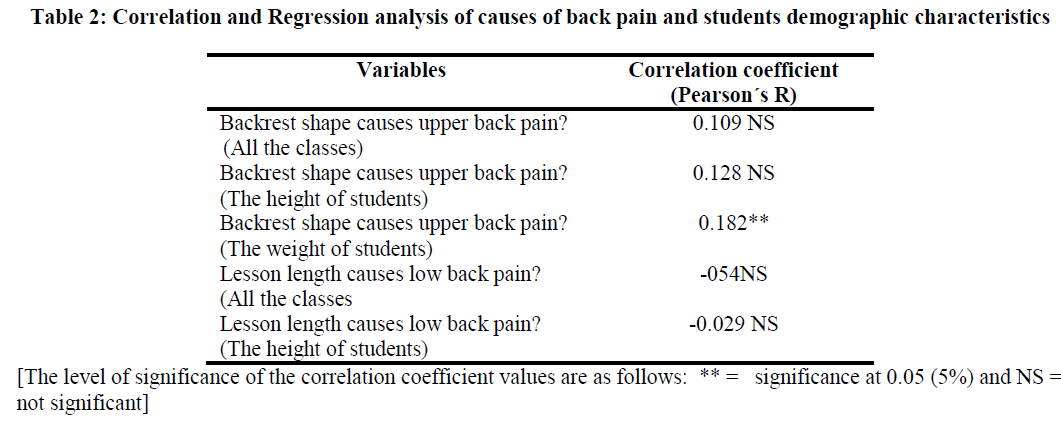 |
| From Table 2, the correlation coefficient obtained for the causes of back pain and students demographic characteristics indicated backrest as a cause of upper back pain according to the weight of students with a significant value (i.e. 0.182). However, the backrest shape, the cause of upper back pain according to the height of students was negatively insignificant (i.e. - 0.128) but backrest shape as cause of upper back pain to students in the classes had positively significance (i.e. 0.109). There were negative insignificant values for lesson length causing low back pain to students in all the classes and lesson length causing low back pain according to the heights of students had values (i.e.-0.054 and - 0.029), respectively. |
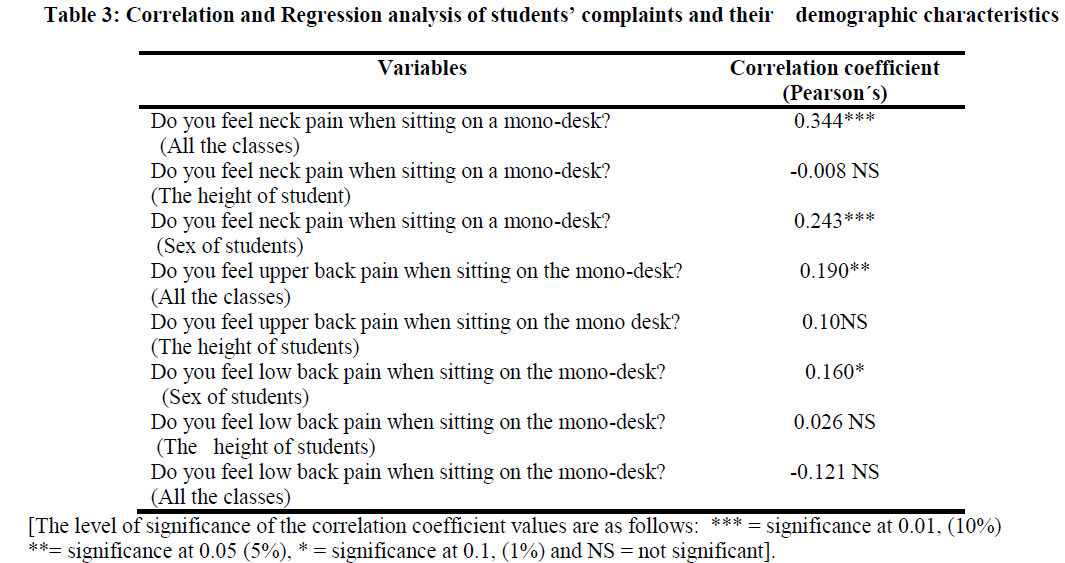 |
| The result in Table 3 showed correlation of complaints students made on pains associated with the use of mono-desks in classrooms. Students in all the classes, both male and female complained when they use the mono-desk and were significant at 10% (0.344 and 0.243), respectively. The correlation between upper back pain and mono-desk according to students in all classes was significant at 5% (i.e. 0.190) and correlation of complaints between low back pain and mono-desk according to both male and female students was significant at 1% i.e. (0.160). However, the correlation of complaints between low back pain and mono-desk according to students heights were negatively insignificant (i.e. 0.026 and 0.121), respectively. The correlation of complaints between upper back pain and mono-desk according to the height of students was positive but not significant (i.e. 0.109) and also the correlation of neck pain between and monodesk according to height of students was negatively insignificant (i.e. -0.008). |
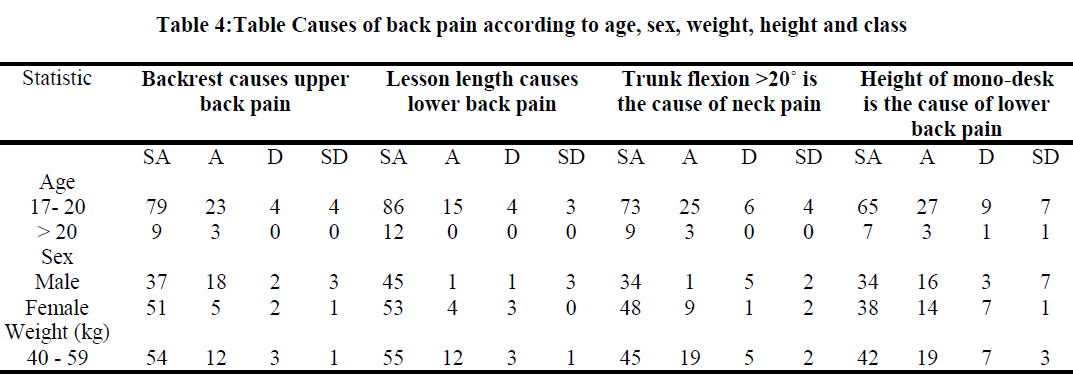 |
 |
| Sitting should be enjoyed; it should not be endured [14]. From Table 4, majority of the students concluded that backrest, lesson length, trunk flexion and height of mono-desk causes back pain, lower back pain and neck pain. Ergonomic chairs make everyday sitting as an enjoyable activity [14]. Sitting in a static posture will even increase the stress in the back, neck, arm and legs, and add a great amount of pressure to the back muscles and spinal disc. Proper seating in a well-constructed chair can help reduce fatigue and discomfort, increase blood flow, reduce the risk of injury and increase productivity [4]. |
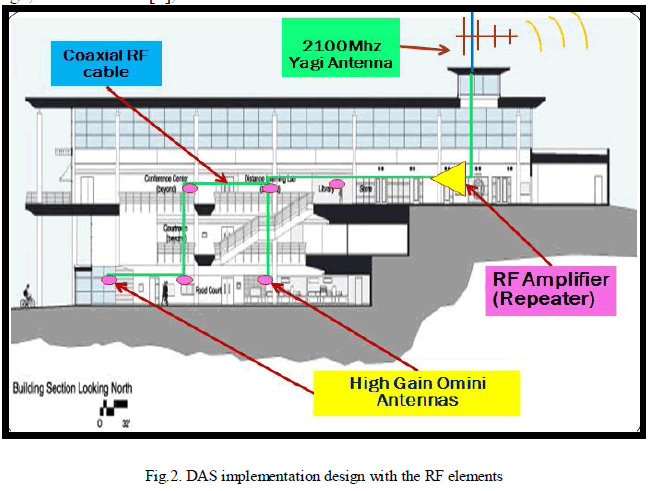 |
IV. DISCUSSIONS |
| There are many basic principles involved in the design of an ergonomic desk or chair, most of which are very easy to understand. A good chair is important because nowadays most students spend a good portion of every day working on their tables and chairs or using it for writing [15],[16]. It is hard to ignore that almost everywhere you go you see people sitting in chairs that look cheap, old, flimsy and just plain inadequate for daily use. Investing in the right ergonomic chair will reward students with increase comfort at the classroom and a decreased risk of developing any serious condition in the future [17]. |
Regression analysis of the causes of back pain |
| From the regression analysis carried out on all the selected variables or causes of various back pains, it was found that backrest shape the cause of upper back pain was influenced by the height of the students. The pain could be contributed by sitting with awkward or static postures, as well as students not fitting into the furniture. This may be when students sit with the trunk flexed increases the spinal load, compared to standing and prolonged static sitting increases instradiscal pressure, resulting in decreased nutrition to the disc and also causing pain at the back of the body. |
Regression analysis of students’ satisfaction with classroom furniture |
| From the regression analysis carried out to find the dissatisfaction with the height of classroom furniture according to the weight of students, showed the height of the mono-desk in the classroom had significant influence on students in their studies. This level of dissatisfaction with classroom furniture means that there is anthropometric mismatch between the dimensions of the furniture available and anthropometric characteristics of students as stated by Castelucci et al. [18], Murphy et al [19] and Parvnue et al [20]. Also due to students’ variability in sizes that exist among them, they may be very unlikely that furniture of fixed dimension will fit the majority of students as suggested by Parcells and Stommel et al.[21]. Thus there should be improvements in the design of the classroom furniture that are used by students. This is to ensure the wellbeing or comfortability of the students’ usage of furniture during their schooling years and thus will determine their future body postures. |
Regression analysis of students on the complaints of back pain |
| Students experiencing neck pain when they sit on the mono-desk was significantly associated with gender and class. This shows that students who sat on the mono-desk had a significant influenced in the incidence of neck pain. This may be due to the fact that students feel uncomfortable when they adopt flexed or static postures for prolonged periods of time, increasing muscular fatigue in the neck thus causing pain in the neck pain and back pains. |
Classroom sitting and postural alignment |
| Students sitting close to the walls normally flex their necks when looking on the chalkboard to write. This affects the first three students on the front rows on the wall, but do not affect the rest of students sitting at the rows closed to the walls. This is due to the fact that these students either rotate or flex their neck when looking on the chalkboard in front of them. Students sitting in the three middle rows in the do not flex their necks because the chalkboard is in front of them, straight in the classroom. |
V. CONCLUSION |
| This study on ergonomic impact of furniture design on the health of students was necessitated by the need to look into the health problems posed to students by furniture used in the classroom, its compatibility to users and the number of movements students make in the furniture. The study looked at the design features of mono-desk and its compatibility to the user needs. Students’ furniture contributed to different postures of students in the classroom regardless of the furniture. This will array the fears in students that sitting is not a risk factor but certain types of furniture may contribute to postural discomfort which will eventually lead to pains at the back of students. Unconducive furniture in classroom also promotes greater frequency of posture changes which normally distract students’ attention during lesson and also brings negative health implication to students. |
| Finally, an ergonomic intervention is required to redesign the classroom furniture for students at different age groups in order to reduce furniture related health problems. Appropriate designs of classroom furniture with consideration of body dimensions of students and other ergonomic factors may be helpful for reducing health problems and improving the posture of students in the classroom. |
Recommendations |
| Students realized the important features that contribute to good furniture design and recommended some valid suggestions; |
| • Students preferred furniture with broad seat, clearance space for thighs and legs in order for them to feel comfortable in the classroom when they sit in the mono- desk. |
| • If local carpenters are going to continue to produce and sell traditional designed furniture, schools need to be encouraged to at least provide much variety in furniture sizes as possible to accommodate the variety of students’ sizes. |
| • Different types of furniture with variations in models should be used by students in classroom to minimize discomfort at the different parts of the spinal cord and also adopts S posture in the furniture. |
| • Though, the mono-desks designed and constructed use less timber products as compare to the construction of separate table from the chair. It recommended that the chair should be constructed separately from the table in order for them to adjust the distance between the table and chair for easy movements and to avoid students remaining static posture in the mono-desk. |
| • Provision for footrest, wide work surface, and wide books and bags storage, strong and durable wood should be incorporated in the design and construction of classroom furniture to avoid mismatch between students’ body dimensions and chairs. |